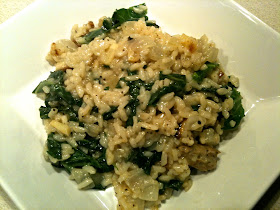
The last two weeks, I've tried to make simple winter salads. The second week turned out significantly better than the first. Here's a look at what happened:
Week #1: Spinach, Grapefruit, Fennel, Radish and Bacon Salad with Lemon-Ginger Dressing
This salad was doomed from the start. First, I wasn't able to get all of the ingredients I'd intended to use. Giant and Whole Foods were both sold out of arugula, so I decided to substitute spinach. I wanted to include radicchio, both for color and its bitter taste. I couldn't find that either, so I decided to use radishes instead, which also have a bitter/spicy flavor, although less pronounced. Sometimes, substitutions like this can lead to something exciting and unexpected. Unfortunately for this salad, it just led to something less flavorful.
Peeling grapefruit is a chore, as its pith and inner membranes are notoriously difficult to separate. I'd read about a
technique to boil the grapefruit first for about five minutes, which causes the pith to expand and separate, making peeling much easier.
Indeed, doing so did make the grapefruit easier to peel and I ended up with lovely pink sections free of bitter pith. Unfortunately, I also ended up with a residue in my nonstick saucepan that will not come off. Great.
In the end, the salad looked nice, but was lacking in flavor. Once dressed with a lemon-ginger olive oil dressing, it just seemed really too soggy and kind of bland. Not even the bacon could save it. I'd made a salad before with grapefruit, radicchio and endive that was really good. This, unfortunately, was not.
Week #2: Arugula, Fennel, Radish, Fig, Walnut and Chicken Salad with Balsamic Vinaigrette
This salad, on the other hand, was quite tasty. Having learned my lesson from the previous week, I was not going to attempt another creative salad unless I could find arugula, which thankfully Giant had this week (and it was a nice peppery batch).
I dredged chicken cutlets in flour mixed with seasoned salt and pepper and sautéed them in olive oil. The flour dredge gives the outside a slight crispness and helps seal in moisture.
I shaved the fennel and sliced the radishes with my mandolin like the week prior, although this time I added calimyrna figs for sweetness, which also added some crunch due to their seeds. I also tossed in some toasted chopped walnuts, which added rich, nutty flavor.
For the dressing, I went with an old stand-by: standard balsamic vinaigrette, for which I combined extra-virgin olive oil, Dijon mustard, honey, balsamic vinegar, a little sea salt and fresh-ground black pepper.
The results were a marked improvement from last week's salad. Quite tasty. The figs and walnuts went together great with the other ingredients and the dressing pulled it all together. Hooray.
Arugula, Fennel, Radish, Fig, Walnut and Chicken Salad with Balsamic Vinaigrette
By A. Huddleston
2 tbsp extra-virgin olive oil
2 tbsp flour
seasoned salt and fresh-ground black pepper to taste
3/4 lb boneless/skinless chicken breast cutlets
3.5 oz baby arugula, washed
1/4 fennel bulb, thinly sliced
4 radishes, sliced
3 figs, quartered and chopped
1/3 cup chopped walnuts, toasted
Dressing:
3 tbsp extra-virgin olive oil
1 tsp Dijon mustard
1 tsp honey
2 tsp balsamic vinegar
Fresh-ground sea salt and black pepper to taste
1. Heat olive oil in a medium-size frying pan over medium heat. Combine flour, seasoned salt and pepper with a fork on a small plate. Pat chicken dry with paper towels and dredge in the flour mixture. Add to frying pan once oil is hot and sauté until browned, about 5 minutes on each side. Set aside to cool before cutting up.
2. Whisk together dressing ingredients until well combined.
3. Combine arugula, fennel, radishes, figs and walnuts in a large salad bowl. Toss with dressing. Cut up cooked chicken cutlets and serve salad on plates topped with chicken.























































